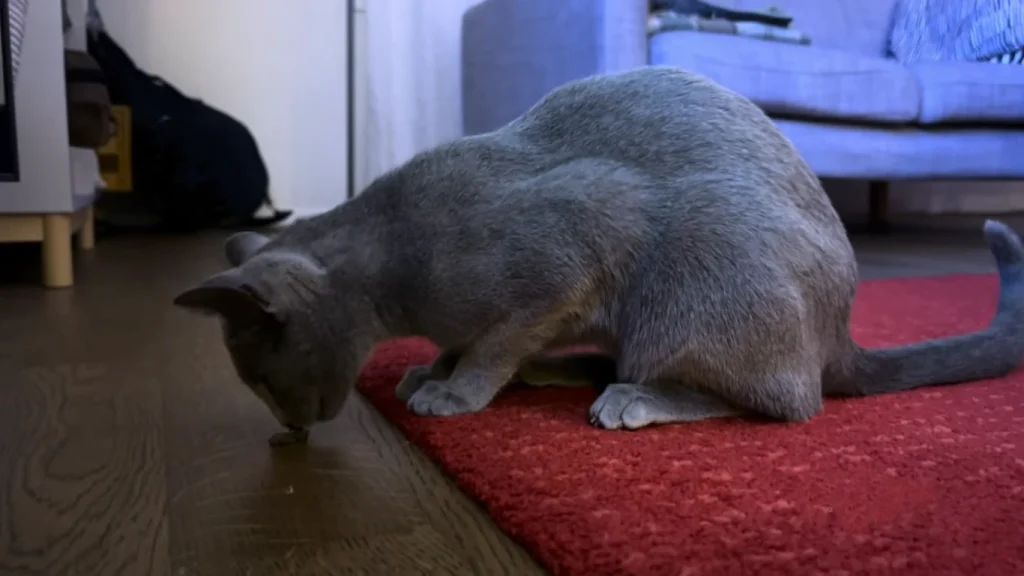Can Cats Eat Moths? Understanding the Safety and Nutritional Value
By: Lana Koh

The information in this article is intended to educate cat parents and is not a substitute for veterinary guidance. In case of any concerns about your cat’s health, please talk with your veterinarian.
Many cat owners wonder if it’s safe for their pets to eat moths. The occasional moth won’t harm a cat, but caution is advised since some species could pose risks. Cats are natural hunters and enjoy chasing insects, including moths, which can be quite tempting for them.
While most moths are not toxic, there are some considerations to keep in mind. If a cat consumes a large number of moths or eats a potentially harmful type, it may lead to health problems. Understanding the dietary habits of cats can help owners make informed decisions about what their pets can safely munch on.
It’s essential to balance a cat’s natural hunting instincts with safe eating habits. Knowing when to intervene can keep cats happy and healthy while satisfying their playful nature.
Key Takeaways:
- Most moths are safe for cats to eat.
- Eating a lot of moths may cause digestive issues.
- Cats love hunting moths and this behavior is natural.
Also Read: Can Cats Eat Mushrooms?
Nutritional Considerations of Moths in a Cat’s Diet
Moths can occasionally be part of a cat’s diet, but there are important factors to consider regarding their nutritional value and safety. Understanding the protein content, comparing moths to commercial cat food, and recognizing the risks from wild moths helps cat owners make informed choices.
Assessing the Protein Content in Moths
Moths are primarily composed of protein, which is essential for a cat’s growth and maintenance. On average, moths contain about 40-50% protein on a dry weight basis. This is beneficial for cats, as they are obligate carnivores and require high protein in their diets.
Comparing this to traditional cat food, which typically contains 25-35% protein, moths provide a concentrated protein source. However, the protein quality may differ. Cats need specific amino acids, such as taurine, which may not be present in sufficient amounts in moths.
Comparative Analysis of Cat Food Versus Moths
When considering the nutritional benefits of moths versus cat food, it’s vital to note the difference in ingredients. Cat food is designed to meet a cat’s complete nutritional needs, including vitamins and minerals.
Moths do not provide the same comprehensive nutrition. While they offer protein, they lack the essential nutrients found in commercially prepared cat food. Relying solely on moths could lead to nutritional deficiencies over time.
For a balanced diet, moths can be a treat but should not replace regular meals. Regular cat food ensures cats have all necessary nutrients for optimal health.
Also Read: Can Cats Eat Tuna?
Risks of Ingesting Wild Moths
While most moths are safe for cats, risks exist, especially with wild moths. Cats could ingest moths treated with pesticides or insecticides. These chemicals can pose serious health risks, leading to vomiting, diarrhea, and other symptoms.
It’s important for cat owners to monitor their cats when they catch and consume moths. Some moths, particularly those from the caterpillar stage, may be toxic. Owners should avoid letting cats eat moths from unknown sources and provide safe alternatives for protein intake whenever possible.
Potential Hazards for Cats Eating Moths
When cats eat moths, there are several potential hazards to consider. These include the toxicity from pesticides, the risk of insecticides used for pest control, and the chance of moths being vectors of disease. Understanding these risks helps in making informed decisions about a cat’s diet.
Toxicity of Pesticides on Moths
Moths can carry pesticide residues from their environment. These chemicals can be harmful to cats when ingested. Many pesticides are designed to kill insects, but they can also affect larger animals. Symptoms of pesticide poisoning in cats include vomiting, diarrhea, and lethargy.
It is essential to know where your cat is hunting. If there are recently treated areas with pesticides, it is best to keep your cat indoors. The chances of ingesting harmful substances increase significantly in treated areas.
Read: Can Cats Eat Tofu?
Insecticides Used in Pest Control
Insecticides are commonly used to control moth populations. Many of these products are toxic to cats. Insecticides designed for indoor or outdoor use may linger on surfaces or in the air. If cats eat moths that have been exposed to these chemicals, they may suffer adverse effects.
Signs of insecticide poisoning may include respiratory issues, lethargy, and digestive disturbances. Pet owners should be cautious and consider keeping their cats away from areas where insecticides have been applied.
Moths as Vectors of Disease
Moths, while not typically known for spreading diseases, can occasionally carry pathogens. These microscopic organisms can be transmitted to cats if they consume infected moths.
Infection risks vary, but some diseases can lead to serious health issues in cats. Symptoms might include fever, loss of appetite, or unusual behavior. Keeping track of your cat’s hunting habits can help minimize the risk of disease transmission.
Considering these potential hazards is crucial for the health and safety of cats. Pet owners should be aware of the risks that come with their pets hunting and eating moths.
Behavioral Aspects of Cats Hunting Moths
Cats are natural hunters. Their instincts drive them to chase various moving objects, including moths and flies. This behavior is not just about acquiring food; it plays an essential role in their mental and physical health.
Read: Is Pumpkin a good food for Cats?
Cats’ Instinct to Chase Flies and Moths
Cats have a strong instinct to chase anything that moves. The fluttering of a moth or the flight of a fly captures their attention. This behavior is deeply rooted in their ancestry as hunters.
When they spot a moth, they may stalk it with a low, crouched position. Then, they pounce, using their sharp claws to catch their prey. This natural hunting behavior helps keep them agile and sharpens their reflexes.
Even indoor cats show this behavior when they catch sight of flying insects. It’s not just about eating; it fulfills their need for stimulation and exercise. Toys mimicking moths or flies can engage them just as effectively. Some cats may even enjoy chasing after artificial bugs infused with catnip to enhance their hunting experience.
Impact of Hunting on Cats’ Well-Being
Hunting behaviors benefit a cat’s mental and physical health. Engaging in these activities can reduce stress and prevent boredom. When cats chase and catch moths, they release pent-up energy, which can lead to a happier pet.
This outdoor activity also engages their senses. The movement, sounds, and scents associated with hunting stimulate their brains. It keeps them mentally sharp and content.
Creating a safe environment for cats to hunt can improve their overall well-being. Allowing them to chase safe insects or providing interactive toys help fulfill this instinctual need. Cats that have opportunities to express their hunting behavior tend to exhibit fewer behavioral issues, making them better companions.
Interesting Read: Why does my cat’s breath smells like fish?
Frequently Asked Questions
Many cat owners wonder about the implications of their pets eating moths. Understanding the risks and necessary actions can help ensure the cat’s health and safety.
Conclusion
Cats eating moths is generally safe, as most moths aren’t toxic and can even provide a small protein boost. However, risks like pesticides, insecticides, or potential toxins mean moderation is key. Letting your cat indulge their hunting instincts is fine, but keeping an eye on their intake ensures they stay healthy.
For a balanced diet, moths should never replace high-quality cat food, which offers complete nutrition. If your cat frequently hunts insects, consider safer alternatives like interactive toys. Staying informed helps you protect your feline friend while letting them enjoy their natural behaviors.

About the Author
Lana Koh
Lana is a passionate cat lover with years of experience caring for her feline companions. As a dedicated volunteer at animal shelters, she’s gained valuable insights into the world of cats. Lana channels her love and knowledge into writing informative and engaging articles for fellow pet owners, covering topics like cat health, nutrition, grooming, behavior, and the special bond we share with our feline friends.
